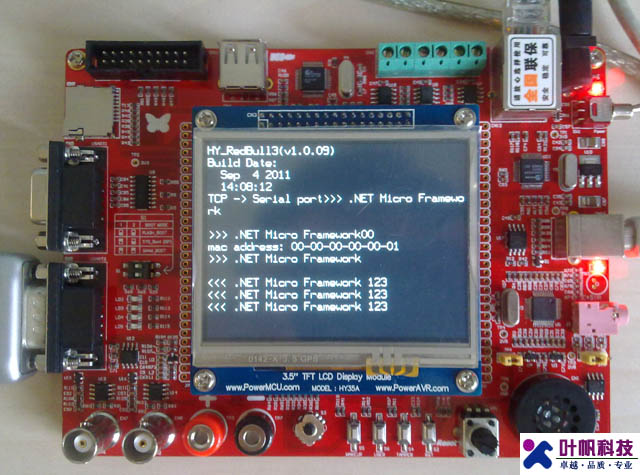以太网转串口是工控领域最常见的智能通信模块,有的是一网口转1串口,有的是一网口转4串口,最多的可以达到一转16串口(好像有的最多可以支持32串口)。如果该类模块做的足够完善,可以提供一个windows系统的设备驱动,安装后,在windows系统上就可以看到虚拟出的串口了。不过这样做,虽然简便了开发,但是性能有些问题,所以有的模块还支持直接用TCP或UDP进行连接,不同端口号对应不同的串口,这样编程可以达到一个比较高的数据吞吐量(我在上个公司用Moxa 5630模块开发隧道广告的数据通信时,就遇到类似问题,也就是最大限度地提高单位时间的数据吞吐量)。
现在我们就用.NET MF网络开发板做一个一网口转1串口示例演示。
简单期间,网络部分的代码,我们可以借用《Socket编程之服务端》中介绍的代码,串口部分的代码,我们可以参考《远程PLC读写控制》和《PC通过Modbus协议远程操控开发板》中的串口代码来进行改写。
核心代码如下:
public ProcessClientRequest(Socket clientSocket, Boolean asynchronously)
{
sp.Open();
sp.DataReceived += new SerialDataReceivedEventHandler(sp_DataReceived);
//--
m_clientSocket = clientSocket;
if (asynchronously) // Spawn a new thread to handle the request.
new Thread(ProcessRequest).Start();
else ProcessRequest();
}
void sp_DataReceived(object sender, SerialDataReceivedEventArgs e)
{
if (sp.BytesToRead > 0)
{
byte[] bytData = new byte[sp.BytesToRead];
sp.Read(bytData, 0, bytData.Length);
string s = new string(System.Text.UTF8Encoding.UTF8.GetChars(bytData));
System.TinyGUI.Graphics.Print("<<< " + s + "\r\n"); //显示串口接收的数据
m_clientSocket.Send(bytData); //把串口接收的数据通过网络发送出去
}
}
private void ProcessRequest()
{
const Int32 c_microsecondsPerSecond = 1000000;
// 'using' ensures that the client's socket gets closed.
using (m_clientSocket)
{
while (true)
{
// Wait for the client request to start to arrive.
Byte[] buffer = new Byte[1024];
if (m_clientSocket.Poll(5 * c_microsecondsPerSecond, SelectMode.SelectRead))
{
// If 0 bytes in buffer, then the connection has been closed,
// reset, or terminated.
if (m_clientSocket.Available == 0) return;
// Read the first chunk of the request (we don't actually do
// anything with it).
Int32 bytesRead = m_clientSocket.Receive(buffer, m_clientSocket.Available, SocketFlags.None);
byte[] bytData = new byte[bytesRead];
Array.Copy(buffer, bytData, bytData.Length);
string s = new string(System.Text.UTF8Encoding.UTF8.GetChars(bytData));
System.TinyGUI.Graphics.Print(">>> "+s+"\r\n"); //显示网络接收的数据
//---------------------------
if (sp.IsOpen)
{
sp.Write(bytData, 0, bytData.Length); //通过串口发送出去
sp.Flush();
}
//---------------------------
}
}
}
把代码部署开发板后执行,我们直接用我们的TCP Client工具进行测试(下载地址如下:http://www.sky-walker.com.cn/MFRelease/Tools/YFTCPClient.rar)。
打开任意一个串口调试工具,设置波特率115200,准备和TCP Client进行通信。
(开发板有两个串口,其中COM1我们把它设为Debug口,所以不能使用了,我们用的是COM2口)。
测试过程图如下:

可以看出TCP Client工具所发出的信息,串口调试助手已经收到,同样,串口调试助手所发的数据,TCP Client也可以收到。
此时开发板运行状态图如下:

其实,我们比较“牛”一点的是一个网口可以转6个串口(其中一个连接Zigbee,一个是RS485,还带若干IO)的物联网网关模块(如下图),该系统基于STM32F207,正在调试过程中。

---------------------------------------------------------------------------------------------------------------------------------------------
本文源码:http://www.sky-walker.com.cn/MFRelease/Sample/YFMFTCP2Serialport.rar
MF简介:http://blog.csdn.net/yefanqiu/article/details/5711770
官方网站:http://www.sky-walker.com.cn/
分享到:














相关推荐
与教程--FPGA基础入门【11】开发板USB-UART串口通信配置--相应的源代码。 根目录包含: 1. 相关文档,nexys4ddr_rm.pdf是开发板文档;DS_FT2232H.pdf是UART芯片FT2232HQ文档 2. src/包含所有源代码 3. sim/包含...
esp32开发板esp-mesh wifi组网可行性文档分析
两块STM32,一个做主机一个做从机,能够实现主机发送数据以及主机读取从机数据。通过串口调试,以及LED灯来提示工作状态。
近来有些刚入门的用户,不太了解.NET Micro Framework开发板的使用,所以写了这篇文档,以期缩短用户对开发板的熟悉时间。
嵌入式家园-USB转串口转换器用户手册v1.1
mini2440开发板--CMOS摄像头数据手册
.NET Micro Framework开发板原理图(红牛开发板)
这是神舟I号开发板--显示示例,可以正常使用
.NET Micro Framework开发板使用手册(红牛开发板)
STM32_Nano开发板--原理图 很完整 不错,欢迎下载
普中STM32-PZ6806L开发板资料光盘结构 | |---1--用户必看 | |--KEIL5安装教程 | |--普中ARM仿真器使用说明 | |--普中PZ6806L开发板入门教程 | |---2--开发板原理图 | |--彩屏原理图-----------------对应...
德国赫优讯(Hilscher)针对HMI的netX实时以太网开发板NXHMI-RE产品样本pdf,德国赫优讯(Hilscher)针对HMI的netX实时以太网开发板NXHMI-RE产品样本
北京瑞泰公司 DSP开发板 ICETEK-DM642-PCI_原理图_v1.rar 绝对正确 我发现有一个要10分资源分的 那个是骗人的他用的是TI 的EM
STM32F407开发板作为客户端进行网络通信,解压即用
ALIENTEK MiniSTM32开发板例程-库函数版本
Sifive开发板U-BOOT启动信息和调试
开发板USB转串口CH340驱动,硬件开发。 开发板USB转串口CH340驱动,硬件开发。
以太网转串口,以太网转CAN,串口转CAN源码 STM32F103C8T6+W5500以太网开发板 一路CAN, 一路485 CH340 USB转串口, EEPROM 支持串口一键下载 提供原理图与源代码 以太网转串口透传例子 以太网转485 以太网转can OBD...
4412开发板linux-QT下使用wfi设置.